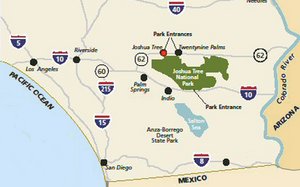Advertisement
Published: September 18th 2017

 the Park's location
the Park's location
It’s in southern California, north of the Coachella Valley, at the juncture of the Mojave and Colorado deserts, starting roughly 140 miles east of Los Angeles. It has been a National Park since 1994.The Joshua Tree National Park is a fascinating place to visit in southern California. It’s a huge territory containing over 1,200 sq. mi. (3,200 sq. km), roughly as large as the State of Rhode Island. About one-third of it is a designated wilderness area, accessible only by foot or on horseback, and what little rain it receives is unpredictable. A good paved road runs through the western part, and there are drivable unpaved roads, plus a number of hiking trails of varying lengths and degrees of difficulty. Mountains run along its southwestern edge, and there is a mile-high lookout point (Key View) that offers a breathtaking panorama of the Coachella Valley and the San Andreas Fault. It is the main destination for most casual visitors.
The Park overlaps two ecosystems, that of the higher elevation Mojave Desert and that of the lower Colorado Desert, each with its own characteristic vegetation. It is named for the “Joshua Tree”, a most unusual plant found almost exclusively in the Mojave Desert section. It can reach 40 feet (12+ m) in height, and lives hundreds of years. There are also five oases populated by fan palm trees and, surprisingly, large animal and bird populations.

 western part
western part
This is the higher level Mojave Desert portion. There is no public transportation to the Park, so you must approach it by car from Interstate 10 and California highway 22 from Palm Springs. There are three entrances … the west one is the one we took. There are also a north one a few miles farther to the east, and a south one, not shown on this sketch. We were only able to visit the north-western portion of the Park this time, but we plan to see more of it on our next trip to California.
Advertisement
Tot: 0.257s; Tpl: 0.014s; cc: 22; qc: 108; dbt: 0.1163s; 1; m:domysql w:travelblog (10.17.0.13); sld: 1;
; mem: 1.2mb

 the Park's location
the Park's location
 western part
western part





























angie
non-member comment
Very interesting place. Great photos. Tell me, what did they mine in Hidden Valley?